Britain is rich with quirks, traditions, and seasonal customs, some of which have died out, others that have endured. Many are based around English folklore and specific historical events.
During the 1970s, renowned British photographer Homer Sykes spent seven years documenting the country's strangest annual traditions. They formed his book Once a Year: Some Traditional British Customs, which has now been re-released, featuring around 80 photos from across the UK, complete with fascinating backstories that Sykes collected at the time.
Here is a selection of the most fascinating and strangest customs, photographed and described by Sykes as they happened in the '70s:
The Burry Man, South Queensferry, Scotland
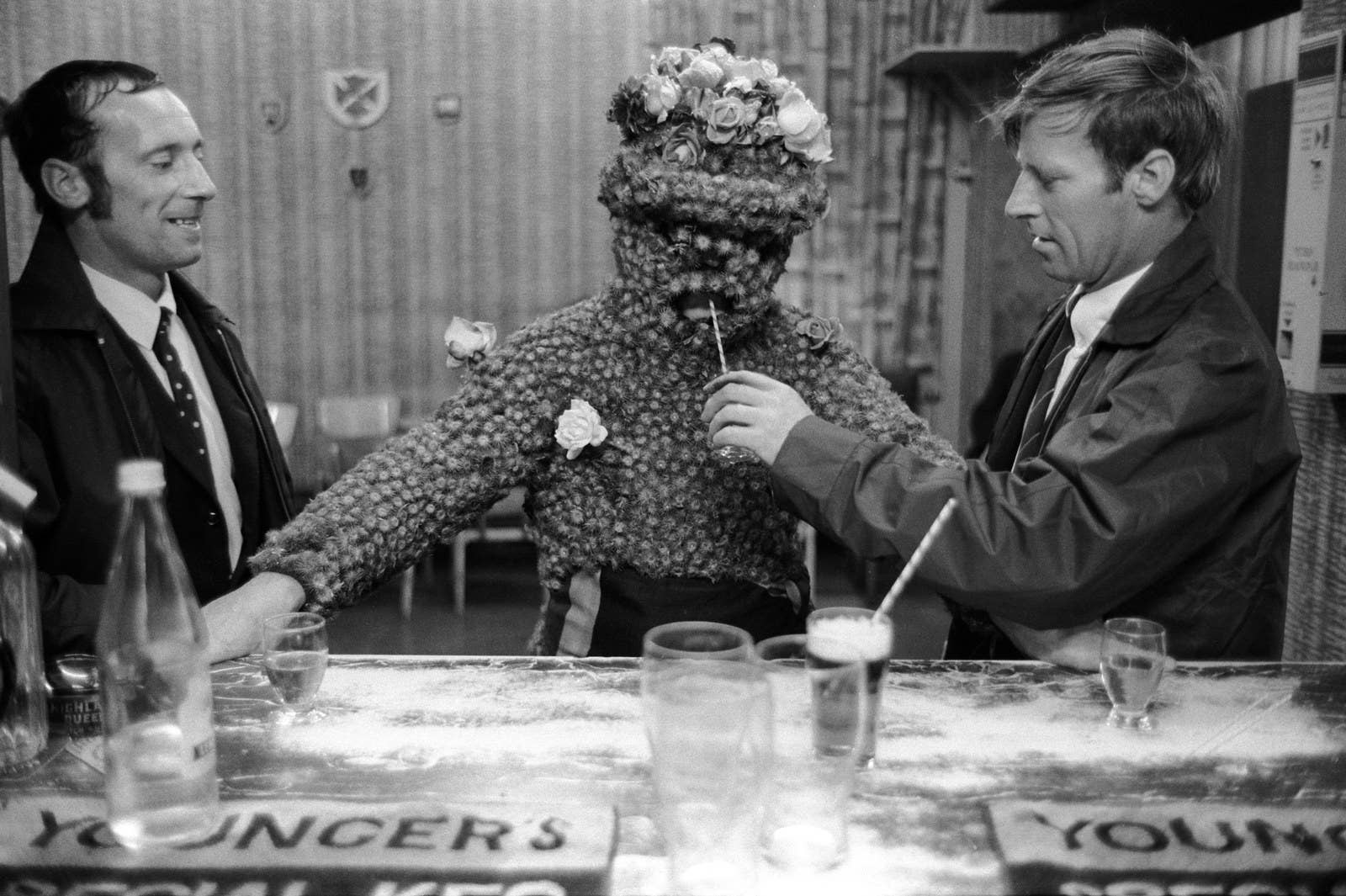
This furry creature is not Chewbacca on a night out – it is the Burry Man, in South Queensferry, near Edinburgh. Underneath this bizarre costume is John (Jacko) Hart, a local gravedigger, seen alongside two companions at a bar in 1971.
The tradition has a lot of history to it: South Queensferry was politically important during the time of the early Scottish kings, because it was the ferry point between the royal palaces of Edinburgh and Dunfermline. In 1364 it became a royal burgh, or borough. South Queensferry was also known for its fishing, with records of herring being cured there since 1792.
However, when herring fishing proved to be a failure, the people of the borough took creative action, calling on the Burry Man. Historian J.M. McPherson explained in 1929: "The fishermen dressed a cooper [a maker of casks and barrels] in a flannel shirt with burrs [prickly seed cases or flower heads] stuck over it, seated him in a hand-barrow, and wheeled him in procession through the town, in order to bring better luck to the fishing fleet."
The Burry Man also traditionally has a red herring dangling from the brim of his hat, sits atop a horse, and is preceded by a piper during his jaunt around the town.
He has not been a regular sight since 1865, as he did not actually manage to guarantee better catches. But local grave-digger Hart still upheld the tradition in the 1970s, as seen above.
Photographer Sykes describes how Hart made his costume: "In the evenings during the preceding week he collects the burrs [seed cases] from a nearby disused quarry, and with them makes up forty-two patches on square brown paper in one of the rooms of the town hall ... Over his face he wears a balaclava back to front, in which holes are cut for eyes, nose and mouth. His helpers then fasten a Union Jack around him and fold on the patches of burrs ... At 10 am he prepares to leave the town hall but not before one final decoration is added — four roses on his front and four on his back .... Throughout the day, accompanied by his two assistants who help him by holding out his arms from his body, and surrounded by young money-collectors, singing 'Hip hip hooray, it's the Burry Man's day', he perambulates the town boundaries, stopping at all the public houses."
This tradition still happens to this day, you can see a video here from 2011 of the Burry Man preparing for his walk around the town here.
Allendale Tar Barrel Parade, Northumberland
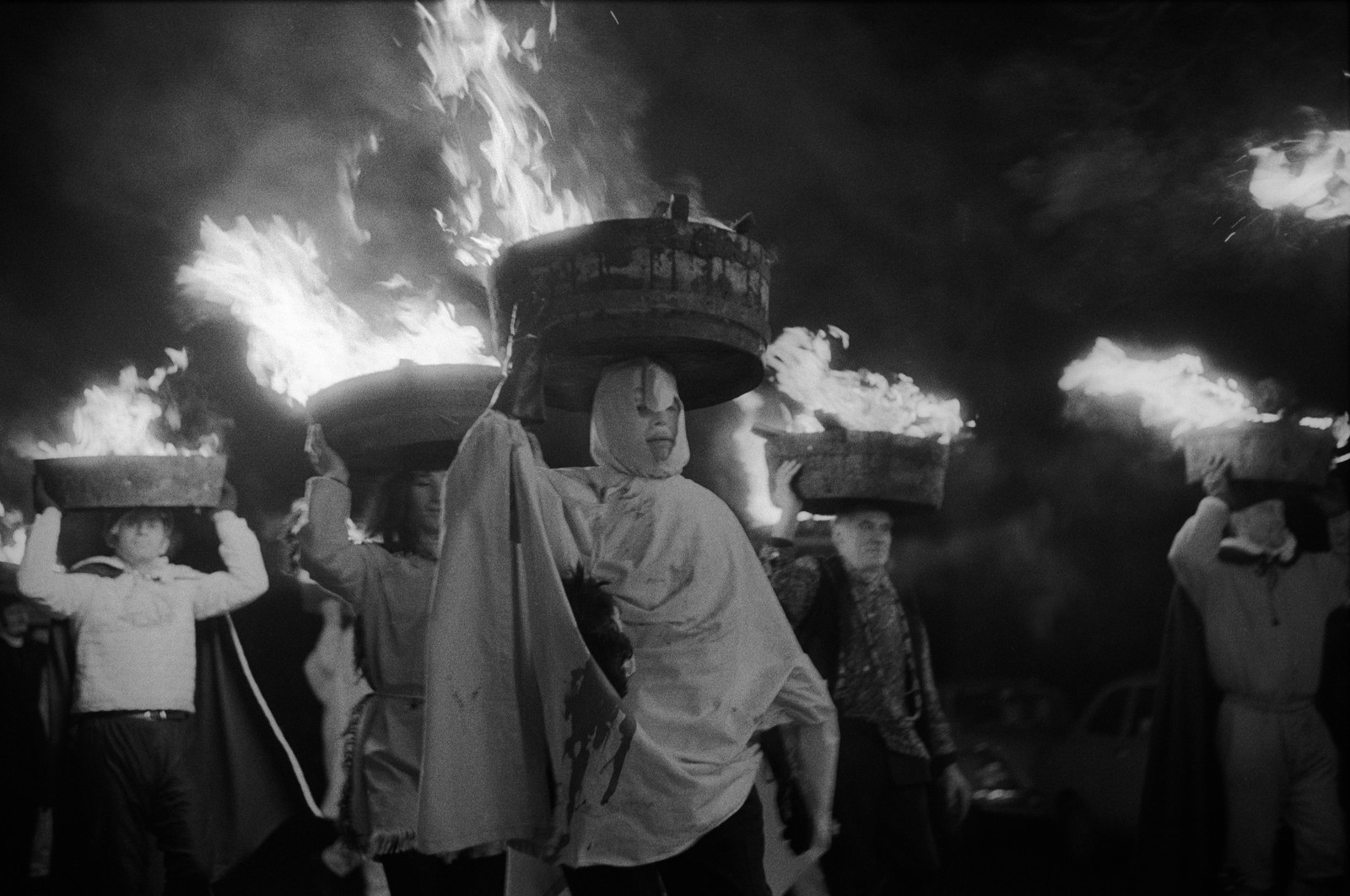
These flame-carrying robed men are "guisers", seen on New Year's Eve in 1972 in Allendale, Northumberland. The flaming tar barrels they carry are used to light a bonfire at midnight to welcome in the New Year. The men adopt a "guise", wearing homemade fancy dress. The earliest record of the Allendale Tar Barrel Parade is from 1884.
The parade may well have begun as a creative way to ensure a bonfire could be lit, regardless of the weather. An account of its possible origin appeared in the local newspaper in 1933: "About seventy four years ago Miss Russell [a local woman]... let her two brothers out to play in the band on New Year's Eve, she going shortly after to watch-night service in the Old Wesleyan Chapel. The night was so wild that the tallow candles to light the music stands, while band played the old year out and the new year in, would not burn. Some bright spark suggested a tar barrel. It was got lighted and the band played round it."
You can still see the Allendale Tar Barrel Parade today, which occasionally makes the news.
Hot Cross Buns at the Church of St Bartholomew the Great
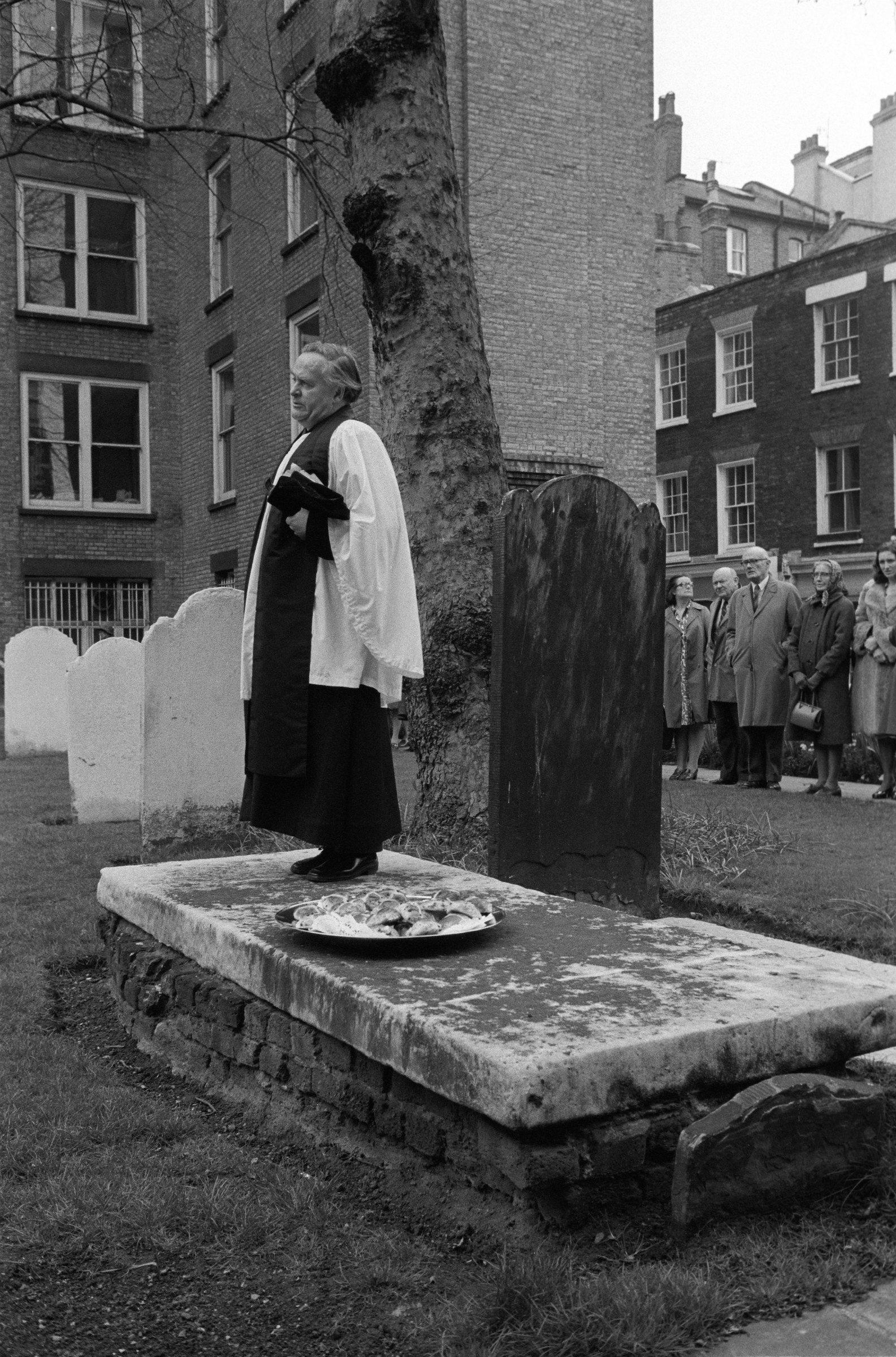
The congregation of the Church of St Bartholomew the Great, in London, meet every year on Good Friday. The rector stands on a large, flat tombstone in the centre of the churchyard with a silver plate containing hot cross buns. He asks the congregation if there are any poor deserving widows present, Easter hymns are sung, and then the hot cross buns are distributed to all present.
This tradition has been followed by the church since 1887, when Joshua Whitehead Butterworth created a trust to provide for poor widows of the parish. The trust was endowed with an investment of 21 pounds and 10 shillings, and a record of Butterworth's instructions reads: “On Good Friday in each year to distribute in the churchyard of St. Bartholomew the Great the sum of 6d. to twenty-one poor widows, and to expend the remainder of such dividends in buns to be given to children attending such distribution and he desired that the Charity intended to be thereby created should be called ‘the Butterworth Charity’.”
To this day, St Bartholomew the Great still distribute buns to widows.
Haxey Hood Game, Haxey, Lincolnshire

According to Sykes, the Haxey Hood Game in Lincolnshire is a rough version of rugby or football and originated in the 13th century.
Legend goes that in 1298, Lady de Mowbray was out riding when her hood blew off. Thirteen farm workers, or "Boggins", who were in the vicinity gave chase to it. It was finally rescued by the "fool", but he was too shy to pass it back to her, so another Boggin (the "lord") gave it back to her. Lady de Mowbray was so impressed with the display of gallantry that in her will she left a piece of land called the Hoodlands to the village, under the condition that the inhabitants re-enact the story every year.
So, on 6 January the people of Haxey and surrounding villages recreate the event in a game where 13 Boggins, the lord, and the chief Boggin wear pink, and the fool is dressed like a court jester.

The tradition goes that the game's players sing in the pub, and then gather at a stone by the village church, where the fool makes a dash from the crowd and the Boggins give chase until he is caught. They carry him back to the stone where he tells everyone about the legend and the rules of the Haxey Hood Game.
The group then make their way to a field, at 4pm a leather hood is thrown up, and a scrum forms around it. The teams of men push against each other to try to get the hood to their favourite pub, which can take several hours. Once the hood reaches a pub, drinks are on the house.
The Haxey Hood Game is still honoured today, attracting some media attention.
Egremont Crabapple Fair, Cumbria

Climbing a 40-foot-tall greasy pole has been a regular custom at the Egremont Crabapple Fair since the 13th century. Sykes tells how a slippery pole was erected in the main street at dawn and youths competed to reach a pound note fixed to the top (previously the prize was a slice of ham). Other games enjoyed at the fair include street races, Cumbrian wrestling, amateur cycling, terrier racing, hound trials, and a pipe-smoking competition.
There is also the famous World Champion Gurning Competition, where people compete to pull the scariest face they can, which is part of the present day Egremont Crabapple Fair.
Abbots Bromley Horn Dance, Staffordshire
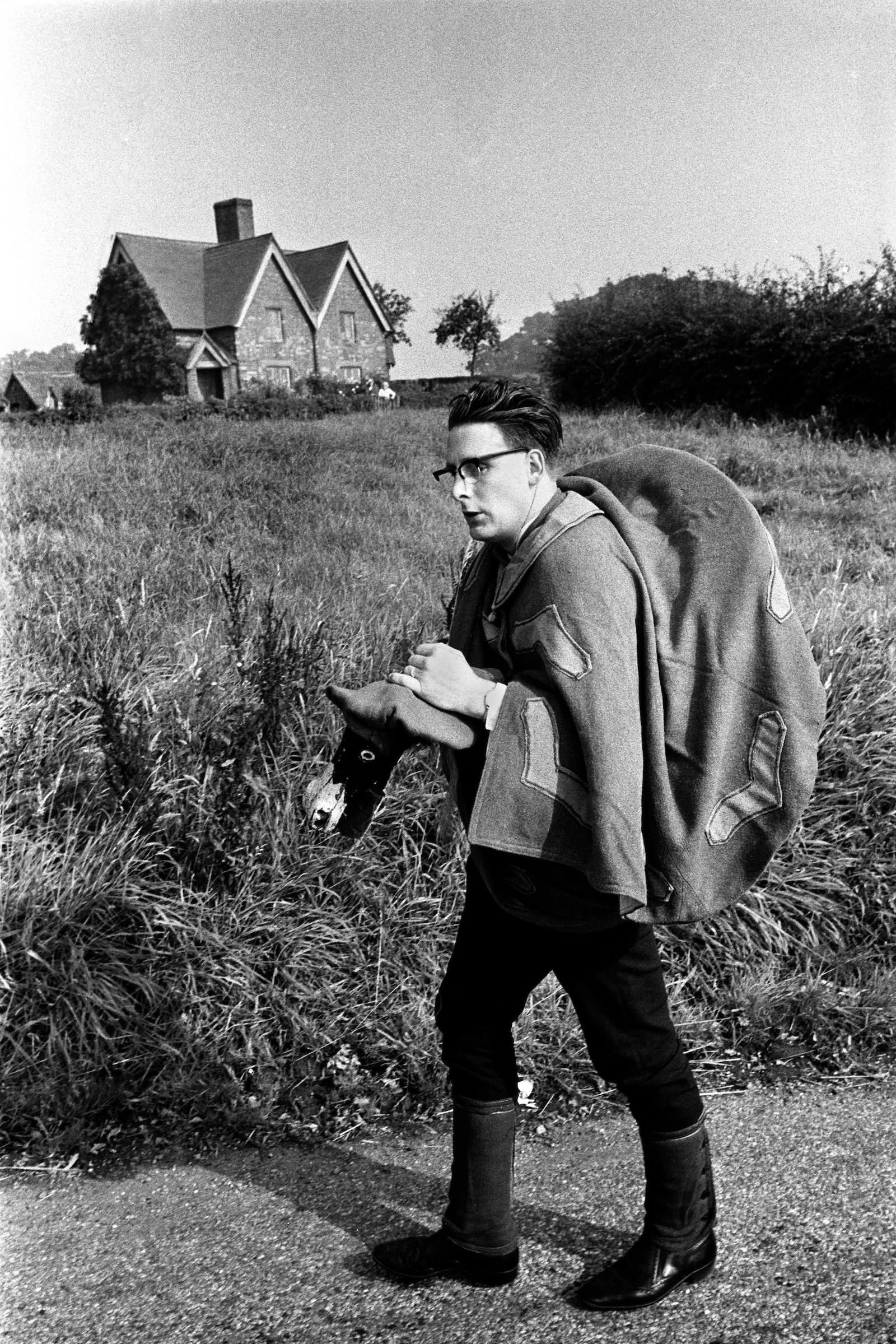
The man above, pictured in 1973, is dressed as a horse – one of a few characters that make up the Abbots Bromley Horn Dance in Staffordshire, including six horn carriers, a boy with a bow and arrow, a jester, and a person dressed as Maid Marion from the tales of Robin Hood. On the day of the dance, the participants gather at 8:30am at the parish church and collect their costumes, including ancient reindeer antlers, some painted white and blue. They then parade to the vicarage, where they perform a dance with the vicar. The group then travel around the village, covering an impressive 20 miles in total.
The earliest reference to this dancing tradition is from 1686. Sykes explained that in the 1970s the leader of the group, Douglas Fowell, who played the accordion, had been in the dance since he was 7 years old, while his family had performed the dance for 400 years.
The Abbots Bromley Horn Dance is still alive and well, you can catch the next one on 11 September 2017.
Westminster School Annual Shrove Tuesday Pancake Greaze
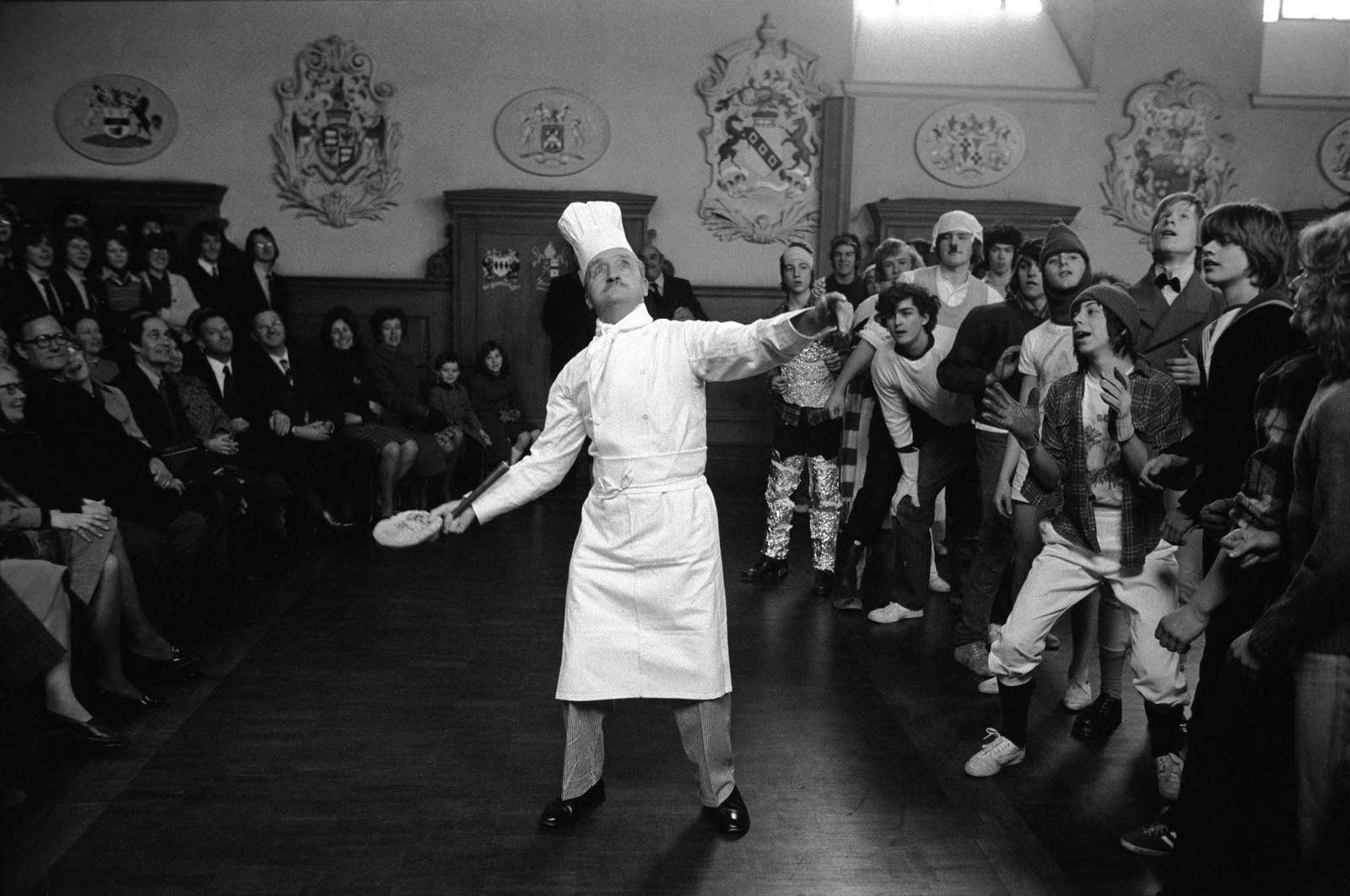
The Pancake Greaze at Westminster School in London, which has been performed for at least 250 years, features the annual tradition of the school cook throwing a pancake over a bar, surrounded by schoolboys who then compete to catch the pancake.
Philosopher Jeremy Bentham, who was a teacher at the school, recorded the tradition in the mid-1700s. In the the 1800s it could involve as many as 200 students, until the headmaster declared a limit on the number.
Sykes explains: "Traditionally the pancake is brought into school at 11am preceded by the college beadle with his mace, and followed by the dean's verger, the dean and the headmaster. On a signal from the latter the cook attempts to toss the pancake over the pancake bar to a line of waiting boys. A Greaze ensues and the boy with the most cake is declared the winner.
"In the past he received a golden guinea from the dean, but for some time now this has always been returned after the ceremony and cash is given in its place. Until 1860 the guinea was not presented if the pancake was torn or touched the ground. Also if the cook failed to toss the pancake over the pancake bar he was 'booked'."
The Pancake Greaze still happens today, but sadly it's not open to the public. The next pancake toss is on 28 February 2017.
The Election of the Mayor of Ock Street, Abingdon, Oxfordshire
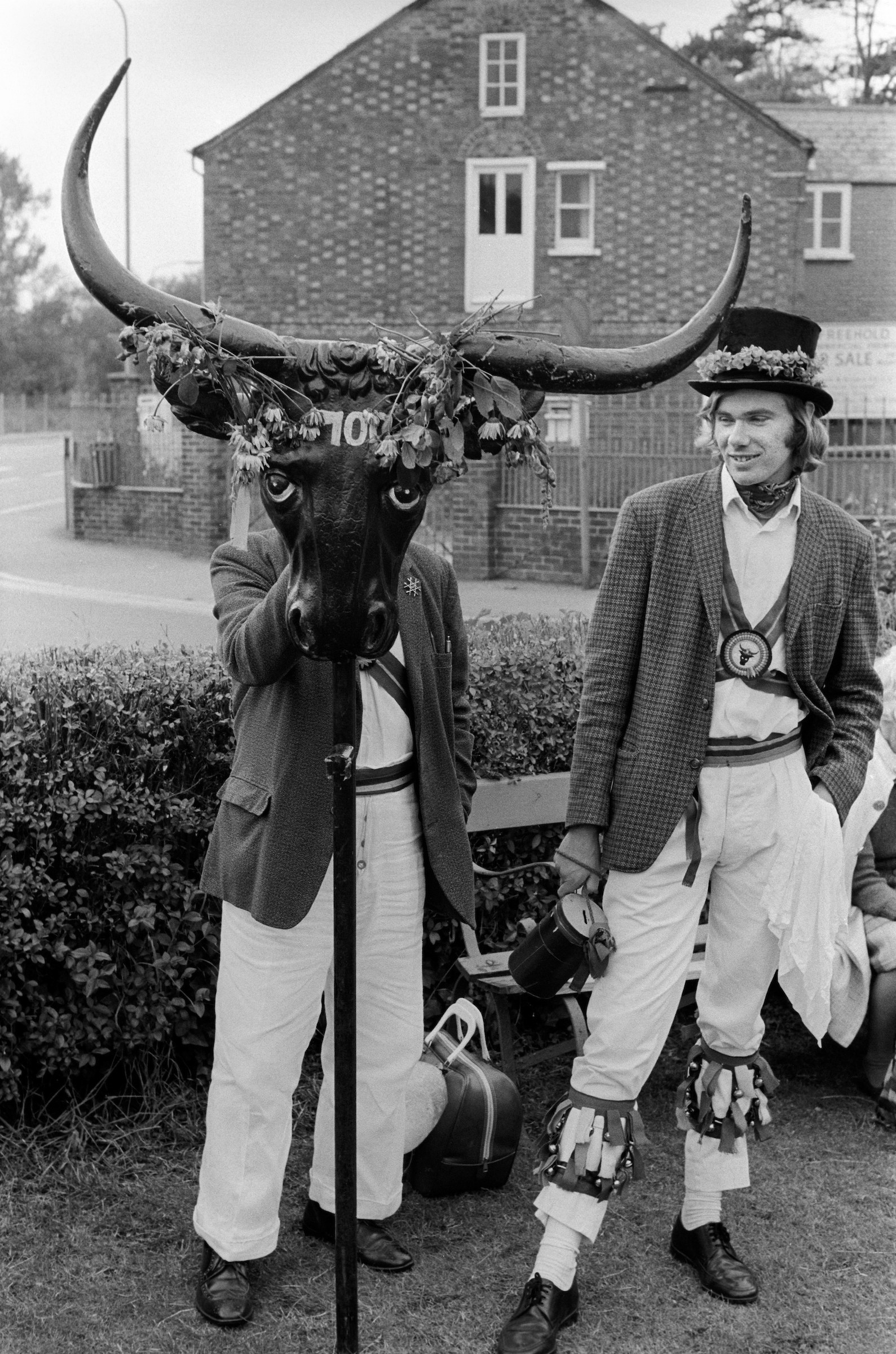
Each year, around 300 residents of Ock Street in Abingdon elect their own mayor on the Saturday nearest to 19 June, which is also known as St Edmund of Abingdon Day.
After the result, things become a little unusual. The elected mayor has a Morris dance performed in his honour, and dresses in a costume including a sash, sword, a collecting box, cup, and the "Ock Street horns". The horns date back to 1700s, when the tradition included roasting a black ox in the market square. History says that one year an argument arose over who should have the horns of the ox, which was then settled by a fight between the men from Ock Street and the men from the east area of the town. The fight involved the wrestling of the two groups over either of two lines in the town. The Ock Street men were victorious, and have had the horns ever since.
The election of the Mayor of Ock Street is still at popular tradition in Abingdon.
Gawthorpe May Day, Yorkshire

In the photo above, Prince Charming and Snow White ride on horseback through Gawthorpe in Yorkshire. The procession is part of the May Day celebrations, a national custom that was recorded by writer Philip Stubbs in 1583: "Against May every parish, town and village assemble together both men and women and children, old and young even all indifferently and either going all together or dividing themselves into companies, go some to the woods and groves, some to the hills and mountains, some to one place, and some to another, where they spend all night in pastimes, and in the morning they return, bringing with them birch boughs and branches of trees, to deck their assemblies withal."
The 142nd Gawthorpe Maypole will happen in the spring of 2017.
The Pinner annual Charter Fair, Middlesex

The Pinner annual Charter Fair has been taking place in Middlesex for almost 700 years, since it was granted by King Edward III in 1336. It was originally founded as an event for cattle and produce to be sold, but over time developed into a pleasure fair, taking place in the High Street. Here we see the "striptease tent" in 1971, an attraction at the fair. A host pulls back the curtain on two performers, as a giant eye of Humphrey Bogart looks on.
The Pinner Fair still draws in visitors to this day.

